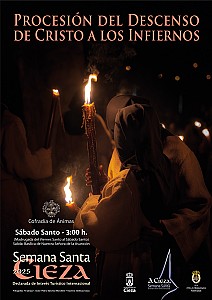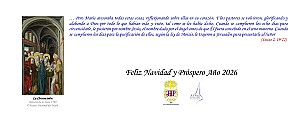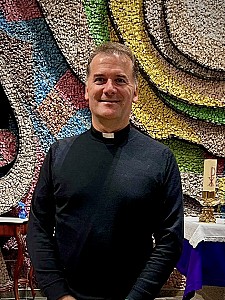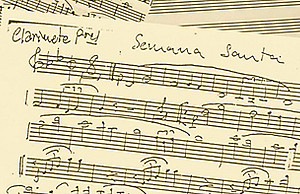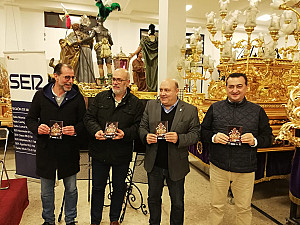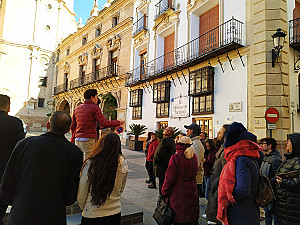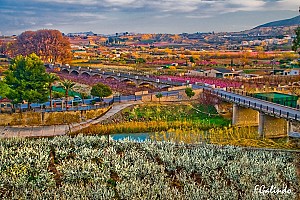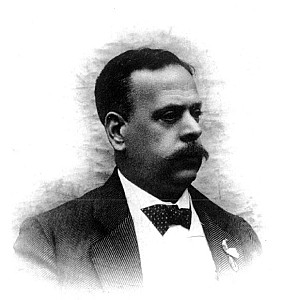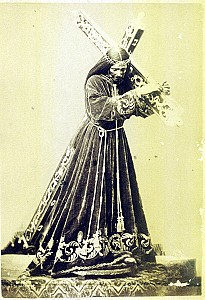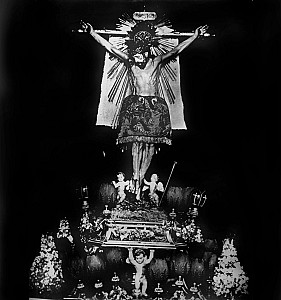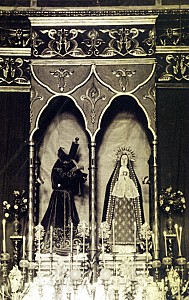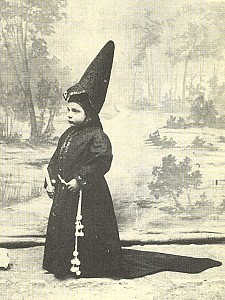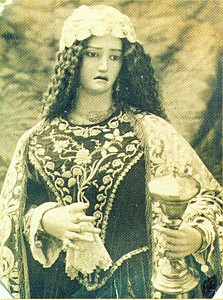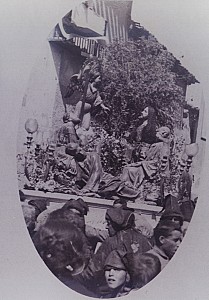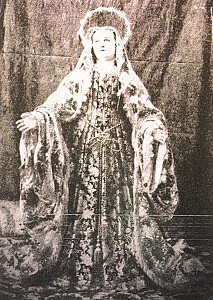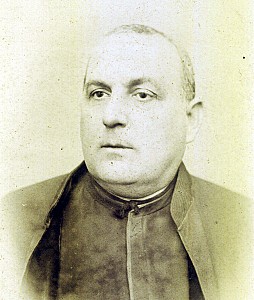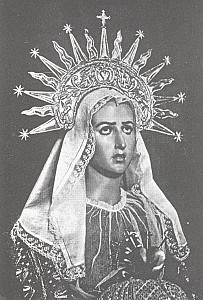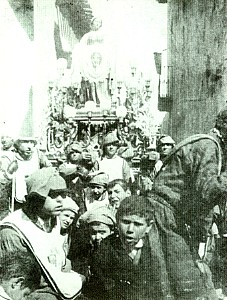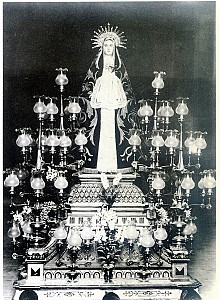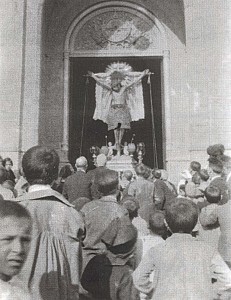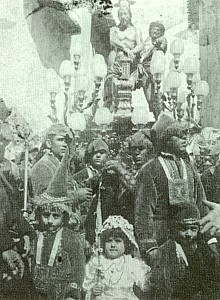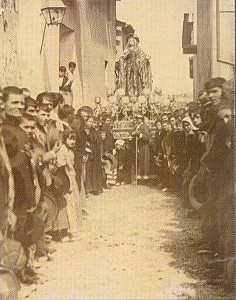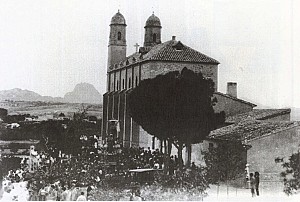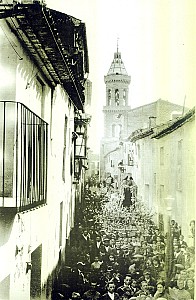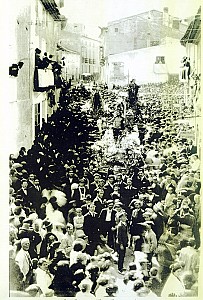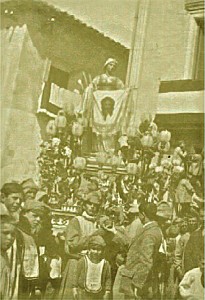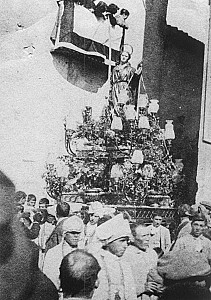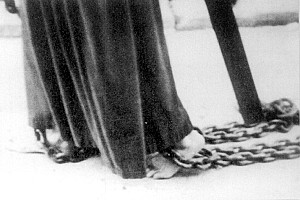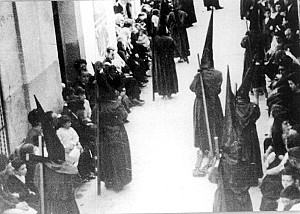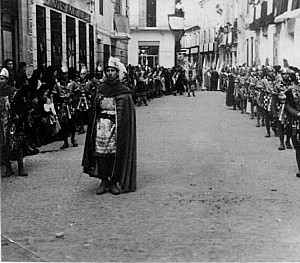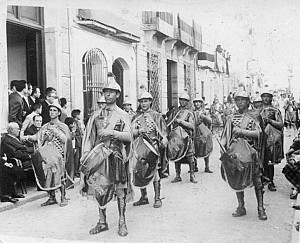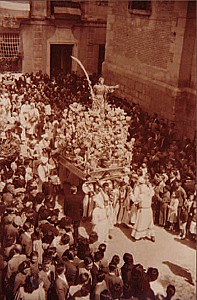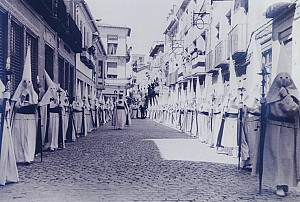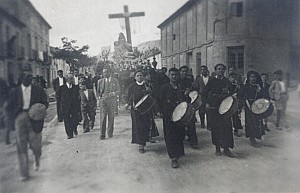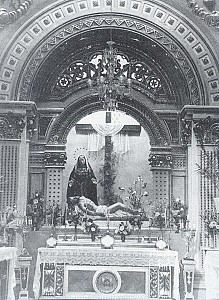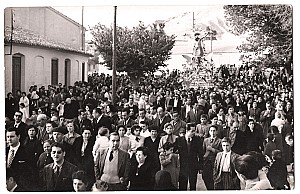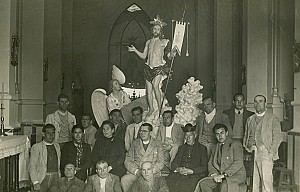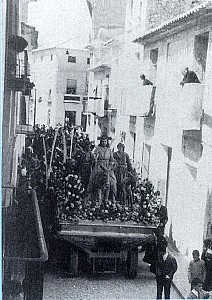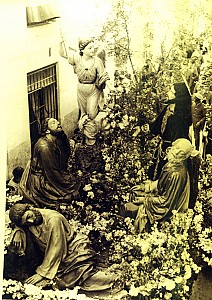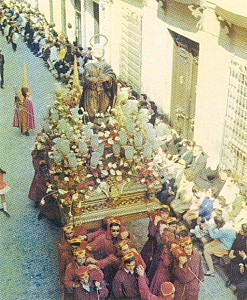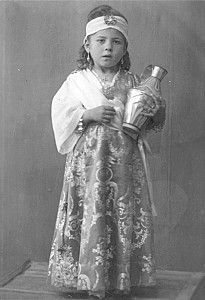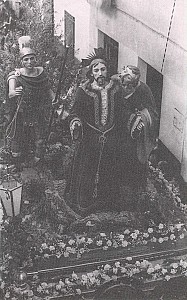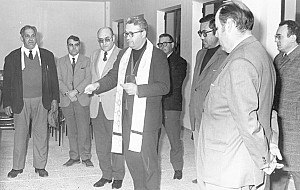INTRODUCTION
It is notorious that the celebration of Holy Week in Cieza, as such, takes place in the period of time between Friday of Dolores (the day before Palm Sunday) and Easter Sunday, although in our town the Processional Parades are They anticipate with various Transfers from the beginning of Lent and have an inaugural celebration on Passion Sunday, seven days before Palm Sunday, with the Processional Transfer of the Banners and the solemn Proclamation, events that have a very wide popular following.
Since Holy Week is determined in the annual calendar by the Jewish Passover, of variable date, its celebration oscillates between the second half of March and the first half of April. To calculate its exact date, it is necessary to go to the astronomical calendar and to a convoluted formulation rule, but of clear content, given that Easter Sunday is located on the first Sunday after the first full moon that takes place after the equinox of spring. So, as an example, to find out when the date of Holy Week in the year 2023 is, we have to perform the following calculation: Find out when the first full moon will be after March 21 (spring equinox), on Thursday, April 16 from 2023; and once this Full Moon of the Astronomical calendar is known, we only have to go to the following Sunday, April 9, 2023, which will be Easter Sunday (Resurrection Sunday).
Due to its coincidence with the beginning of spring, Holy Week benefits from the unique and beautiful setting that, on those dates, the Vega de Cieza offers, whose flowering is, in fairness, one of its main attractions from the landscape point of view .
On the occasion of the flowering, a whole calendar of tourist-cultural activities has been established, in which tourist agencies, local restaurants and hiking groups collaborate.
In any case, the activities organized around Holy Week are not limited exclusively to the dates on which it takes place. The entire Lenten calendar is full of Brotherhood activities, both liturgical and cultural (conference cycles, presentations of new artistic works, concerts, etc.), in addition to the processional transfers of images to the historic center of the town; Also, with less intensity, these activities are distributed throughout the year, in the form of participation in other ciezan festivities (San Bartolomé Fair, Pilgrimage of Our Lady of Good Success and Christmas) as in others celebrated with specific purposes.
Precisely, apart from the El Anda Magazine, the Board of Passion Brotherhoods annually publishes a detailed brochure in which all the activities related to Holy Week that are organized throughout the year are specified.
SOURCE
It is during the preaching of San Vicente Ferrer in Cieza in the year 1411 when he had to pay the ground for the birth of the first Brotherhood of our town linked to the celebrations of Holy Week: the Brotherhood of the Blood of Christ, which could have been in its beginnings a Brotherhood of flagellants. With that mark of antiquity it is collected, by mandate of Felipe II, the Bachelor Alonso Marín y Mena in the year 1579 in his Description and Relation of the Villa de Cieza. “On the twenty-fifth day of the month of March, the year of the birth of our redeemer Jesus Christ, one thousand five hundred and seventy-nine, the bachelor Alonso Marín y Mena, aged forty, and Joan García, the elder, aged eighty , and Martín Ruiz de Soler, the old man, aged seventy-one, neighbors and natives of said town... After forty chapters they said: there are three Brotherhoods, one of the said Apostle Saint Bartholomew, another of the Blood of Christ, and another of the Sweet and Most Holy Name of Jhesus”, testimony that allows us to ensure that both Brotherhoods were fully in force throughout the s. XVI, verifying its antiquity in mandates and testaments of the time.
XVII CENTURY
In 1614, the Hermitage of the Holy Christ of Calvary (today, of the Holy Christ of Consuelo) was built on a hill outside the walls, and on an old humilladero, for which a crucified man was commissioned (1612) under that same dedication and the construction of the stations of a Via Crucis on the slope of said hill. Promoted by the Franciscans at dawn from Thursday to Good Friday, a Via Crucis was carried out with the aforementioned Image, in force until the end of the s. XIX, in which long lines of penitents paraded behind the parish Cross and its Banner making profession of faith and praying.
As for the Brotherhood of the Blood of Christ, it must have taken over at the beginning of the s. XVII the prominence of the primitive Processions of Cieza, since from that moment it had a crucified (attributed by the local chronicler, from the beginning of the 20th century, Ramón Mª Capdevila to Juan de Rigusteza). To that Image will be added as the century progresses a Nazarene with the cross on his back (as stated by the aforementioned Ramón Mª Capdevila) and a Virgin of Solitude (according to a document transferring its belongings after death of his butler), with which (as can be deduced from the request for constitutions of the Brotherhoods of Jesús Nazareno and Ntra. Sra. de la Soledad from the end of that century, in which it is revealed that both Pasos have already paraded long ago) will lead the Processions of Holy Thursday in the evening (seed of the Arrest and the current General Procession of Holy Wednesday) and Good Friday in the morning (genesis of the current Procession of the Penitent), in which the aforementioned Nazarene would parade respectively lit and with the cross on his back, as he does today.
After settling in the Hermitage of San Sebastián at the beginning of the last third of the century, the Franciscans will contribute to the continuity of the Procession of the Holy Burial on Good Friday afternoon, moving the aforementioned Crucified together with a mourning image of the Virgin (Our Señora de la Soledad) to the Parish, where the Images were placed on an altar; It is documented that the Brotherhood starred in the evening of this day in the Act of Descent and the Procession of the Holy Burial with an Image of the dead Christ placed in an urn (as we can interpret from the Capitulations of 1682 for the foundation of the Convent of San Joaquín and the Book of Accounts of the Brotherhood of Jesus in which there is a payment for the repair of the same) accompanied by the aforementioned Virgin.
In 1692, after breaking away from the Brotherhood of the Blood, the Brotherhood of Jesus Nazareno (today the Brotherhood of Jesus –Nazareno–) and that of Nuestra Señora de la Soledad (today the Brotherhood of María Santísima de la Soledad), simultaneously requested constitutions own, being linked to each other in their cults until the beginning of the s. xx. This circumstance, transcendental for the history of Holy Week in Cieza, was due to the desire of the local nobility to disassociate themselves from a Brotherhood such as that of the Blood, made up mainly of artisans of all trades, as well as a desire to reaffirm themselves as socially privileged class.
On the other hand, the newborn Brotherhood of Jesus will absorb the old Brotherhood of the Dulce y Santísimo Nombre de Jesús, of a devotional nature. This fact seems more than evident since still in the s. XX the Brotherhood of Jesus organizes and finances the Function of the Dulce Nombre de Jesús.
A capitular act of 1693 reveals how the Processional Parades had been established at the end of the s. XVII. "This town has the custom and devotion to attend different festivals and general processions by decrees and boots so that at all times it is recorded that those that are agreed upon were the Dulce Nombre de Jesús, Purification of Our Lady, that of Palm Sunday, the of Holy Thursday and Good Friday, that of the Annunciation of Our Lady, Mrs., that of the glorious Apostle Saint Bartholomew... and that all the lords of the chapter have the obligation to attend them without having legitimate impediment under penalty of one pound of wax..." . The one on Holy Thursday would take place in the evening of this day with the participation of the Images of Jesús Nazareno and Nuestra Señora de la Soledad. The one on Good Friday is not the Via Crucis at dawn, but refers to the two Processions that, as previously mentioned, took place that day: one, in the morning, a repetition of the one on Holy Thursday, which The Crucified of the Brotherhood of the Blood would probably be added; the other, that of the Holy Burial, in the evening.
Finally, we also have evidence in this century of the celebration, on the morning of Resurrection Sunday, of another Procession, preceding the current one of the Risen One.
CENTURY XVIII
The new century will witness important changes and innovations; For example, the first documentary references to the dedication of the Santísimo Cristo del Consuelo (called Cristo del Calvario since his arrival in Cieza in 1612, as previously mentioned). The Image was destroyed during the Civil War and replaced at the end of the of this by another of the same date and invoice that is the oldest of all those that participate in our Processions today), which will have its own chapel in the parish church from this time (according to what is stated in mandates and wills), because it is transferred to this frequently in prayer from his Hermitage.
For its part, the Brotherhood of the Blood will be diluted until it disappears in the middle of the century. Its titular Image, if it corresponds to the documented Image of Cristo de la Misericordia (a Crucified donated to the Convent of the Immaculate Conception a few years after its construction, whose aesthetics artistically places it between the 16th and 17th centuries, and which could replace to a previous one), will continue to participate in the Processional Parades until the end of the s. XIX; On the other hand, the Brotherhood of Jesús Nazareno will take charge of the Paso de la Urna (popularly known as the Bed of Christ) with which the Procession of the Holy Burial takes place. Likewise, following the Murcian chronicler and journalist Don Carlos Valcárcel, the present century will bring with it the birth of the Act of Arrest, probably linked then to the Holy Thursday Procession.
In 1724 the Brotherhood of San Pedro was founded, oriented towards a first period that reached the middle of the s. XIX to the worship and celebration of the feast of the Saint, and whose entry into it is allowed in this first period only to the clergy.
The first Book of Minutes of the Confraternity of Nuestra Señora de la Soledad preserved (1730) demonstrates the validity in the middle of this century of the Procession of the Risen Jesus early on Easter Sunday in which said Confraternity processions with its titular Image accompanying to an Image of the Risen Jesus, of which we know that during the following century he received worship in the chapel of the Santísimo de la Parroquial.
Precisely an Act of the Brotherhood of Nuestra Señora de la Soledad reveals the existence in 1767 of four Processions: one in the evening of Holy Thursday; two in the morning and in the evening of Good Friday respectively; and the fourth and last on the morning of Easter Sunday.
On the other hand, at the end of this century the Sermon on Agony will begin to be celebrated at three in the afternoon, which will be uninterrupted until its suppression in the early forties of the s. XX, years in which the Sermon of the Seven Words also tried to be implanted, without success, changing its name to the Function during that brief period of time Oratorio de Agonía y Sermon de las Siete Palabras.
Similarly, the Brotherhood of Nuestra Señora de la Soledad promotes since 1785, at the end of the Procession of the Holy Burial, the Sermon of Soledad, valid until the last third of the s. XX and of which today a slight reminiscence is preserved.
Finally, the census carried out at the end of the s. XVIII as a result of the Decree of the Count of Aranda confirms the existence and legality in Cieza of two Passionate Brotherhoods: Jesús and Soledad; in addition to others like the one of Souls or the one of the Santísimo, that did not participate in the Processions.
XIX CENTURY
From the Books of Minutes we know that, with some exceptions (acquisition of the Paso de La Oración del Huerto or El Señor de la Columna by the Brotherhood of Jesus, creation of the Brotherhood of the Convocatoria de Jesús – organizer since its foundation of the Arrest in the afternoon of Holy Wednesday–,...), the first third of the s. XIX supposed a stagnation in the Holy Week of Cieza; There are two causes that seem to motivate this situation: the War of Independence in 1808 and the successive epidemics that, like the cholera of 1812, profusely affected the residents of Cieza. To these, and as the century progresses, others will be added (suppression of some religious orders, confiscations, expansion of liberalism, and confrontation between the bourgeoisie and the proletariat) that in Cieza will be reflected in a certain abandonment of the Cofrade world.
It will be then when, to remedy the situation, a protectorate for the conservation of the heritage of the Brotherhoods will take shape, which will make families of the local bourgeoisie their own: they flourish like this, gaining an unusual role until then and with a rank similar to or even superior to that of the own Brotherhoods, Camarerías and Stewardships, historically very important since then and until the middle of the s. XX, inasmuch as Waitresses and Butlers become custodians of the assets of the Brotherhoods and responsible for their perfect conservation; Camarerías and Stewardships ended at the end of the s. XIX in authentic patronage in which the figure of the Waitress or the Butler, still in force today in a reduced number of Steps, was the one who assumed the expenses caused by the arrangement of the Step and even the execution of new Steps, on which they maintain property rights, above even the Brotherhood under whose auspices they procession.
This is the only way to explain the relaunch experienced by Holy Week in the last third of the s. XIX, a time in which the wealthy families of the town approach the realization of new Steps (Santa María Magdalena, La Samaritana, Santísima Virgen de los Dolores, Santísima Virgen del Amor Hermoso...) and favor the creation of new Brotherhoods (San Juan, Santa Verónica) or the reorganization of others (San Pedro).
He s. XIX will also witness the consolidation of the Act -Representation, Sermon and Procession- of the Arrest, which is already celebrated outside the Holy Thursday Procession, which in turn is configured as a General Procession, as well as the Courtesy in the framework of the Resurrection Sunday Procession; and the emergence, in its last decades, of a very characteristic event of Holy Week in Ciez, the Bringing of the Saints (Holy Thursday in the afternoon until the beginning of the thirties of the 20th century and Holy Wednesday in the afternoon since then until now), as a preamble to the General Procession, from the extra-walls Hermitage of the Santísimo Cristo del Consuelo to the Basilica of Nuestra Señora de la Asunción.
Thus, in the last quarter of a century the Parades have been structured around Holy Wednesday (Arrest), Holy Thursday (General Procession), Good Friday in the morning (Procession of the Penitent or of the Crosses), Good Friday in the afternoon (Procession of the Holy Burial) and Easter Sunday (Procession of the Risen One)
Holy Week in Ciez even has a date that, over the years, the Bugle and Drum Bands had turned into their own heritage: Dolores Friday. Already from the s. XIX the Brotherhood of the Convocation, the popular "Armaos", blew their bugles and drums on the eve of Passion Week; well into the new century, the night of Friday of Dolores would be reserved for the Armaos and, later, successively, the Bands of the other Brotherhoods and the rest of the town to show the residents of Cieza the marches they had been rehearsing throughout year. From the end of the s. On the other hand, the first preserved photographic testimonies of Holy Week in Ciez date from the XIX century.
XX AND XXI CENTURIES
The initial decades of the new century will witness the birth in 1914 of the Permanent Board of Processions, today the Board of Passion Brotherhoods, derived from the socio-economic circumstances of the moment. The following years will also witness the constitution of the Brotherhood of the Holy Christ of Agony (founder of the Procession of Silence) and of the Holy Christ of Consuelo (subsidiary of the cult Brotherhood of the same name), and the strengthening of the ties that They linked the Pasos that did not have their own Brotherhood with certain trades (San Pedro with the farmers, the Magdalena with the esparto baskets, La Samaritana with those related to weaving...) possibly to ensure their departure in Procession.
The Civil War will mean the disarticulation of the structure of the Brotherhoods that lose a very important and essential part of their patrimony; At the end, the Brotherhoods undergo a considerable transformation and the number of these, after a complicated process of re-foundation (the Brotherhood of the Convocation becomes the Roman Tercio of the Holy Sepulchre; Steps such as San Pedro, La Samaritana, Santa María Magdalena or the Blessed Virgin of Sorrows are constituted in Brotherhoods) and reorganization of the previously existing ones (the Brotherhood of Jesus will give rise to the Brotherhoods of Jesus Nazareno, La Oración del Huerto and El Santo Sepulcro, Jesús Resucitado) and the successive incorporation of other such as the Reclining Christ and Virgin of Sorrow, the Descent of Christ and the Kiss of Judas, the Most Holy Christ of Forgiveness or Our Lady of Grace and Hope, will once again be increased to give rise to the range of colors that survives today, to which was added to end of the s. XX the Brotherhood of Souls, now with a passion character, to currently make up a total of eighteen Brotherhoods that, before thousands of spectators and through its two itineraries, which combine the traditional flavor of the streets and corners of the old town, and the breadth and public reception capacity of the city center, they participate with their forty-three Pasos, always carried on their shoulders, and with their almost six thousand Brotherhood in their eleven Processions (de la Palma, Via Crucis Processional of the Holy Christ of Blood, Order and Procession of the Arrest, General, of the Children of Mary, of Silence, of the Penitent, of the Holy Burial, of the Descent of Christ into Hell, Infant Procession, and Courtesy and Procession of the Risen Jesus).
But throughout these six centuries the great beneficiary has undoubtedly been the socio-cultural and patrimonial baggage that the Brotherhoods have collected and that has seen a notable increase in quantity and quality in the last third of the s. xx; Proof of this are the three Processions born in this period (of the Children of Mary, of the Descent of Christ into Hell, and the Processional Via Crucis of the Holy Christ of the Blood), in addition to the Parade of the Tercios Infantiles (Children's Procession that It currently has thirteen Pasos, which gives an idea of how deeply rooted the festival is in the town and how assured its future is at the same time), the twenty-four Pasos (the most recent, already in full s. XXI, Ntra. Sra. de la Amargura, La Coronación de Espinas and Las Santas Mujeres camino del Sepulcro) and countless belongings that have come to swell the heritage of Holy Week in Ciez, the constant efforts and actions aimed at the restoration and conservation of the itself, and finally the cults, events, publications and activities organized by the Brotherhoods throughout the year, and which represent a high percentage of the socio-cultural and leisure offer of the city.
CONTINUITY IN TIME
As for the organization of Holy Week, for more than a century the Board of Passionate Brotherhoods has been in charge, in its capacity as Superior Council of Brotherhoods, for the organization of all Acts and Activities of a general nature and of all Processional parades of the Ciezana Holy Week. The eighteen Passionate Brotherhoods of the city are made up of the Junta de Hermandades Pasionarias, which, like it, have Statutes approved by the competent authority and their own legal capacity, and which are responsible for organizing their own Acts and Activities.
It is notorious that the celebration of Holy Week in Cieza, as such, takes place in the period of time between Friday of Dolores (the day before Palm Sunday) and Easter Sunday, although in our town the Processional Parades are They anticipate with various Transfers from the beginning of Lent and have an inaugural celebration on Passion Sunday, seven days before Palm Sunday, with the Processional Transfer of the Banners and the solemn Proclamation, events that have a very wide popular following.
The Holy Week of Cieza, has remained in the streets of Cieza, as we have commented in the chapter of The Origin, History and Antiquity, since 1614, but there is a date that the Holy Week of Cieza has as the beginning of a continuity that it has not been possible to eliminate, discounted of course is the Spanish Civil War and the last Covid pandemic, this being that of March 30, 1914, where the Board of Processions of Cieza is constituted, which will give rise to today's Board of Brotherhoods Pasionarias de Cieza, which brings together all the Brotherhoods and Brotherhoods of the town.
It is clear that since we have the possibility of making publications, El Anda, 1931, is the publication par excellence of the JHP (Junta de Hermandades Pasionarias), which has come year after year, encouraging the spirit of Holy Week in the population of Cieza. .
During the year 2020, Easter could not be celebrated due to the health situation derived from the Covid pandemic. During 2021, and once the Pandemic was subsiding, a different Holy Week took place, so that the celebration of the party could last, two types of activities were carried out in reference to Holy Week itself. In one of them, the way of doing Holy Week was changed, that is to say, changing the way of presenting it or seeing it, it has always been to "take the steps out into the street", and it was changed for the viewer to go to see the steps to his House-Museum. And another way of using “virtual” Holy Week where Holy Week in Cieza was made known on Social Networks, in a different programming than usual. Proof of this is reflected from our YouTube Channel; Being this channel the one that is used mostly due to its characteristics, as a means of publications of the Board of Brotherhoods and of the Holy Week of Cieza. (https://www.youtube.com/@JHPCieza)
Due to its coincidence with the beginning of spring, Holy Week benefits from the unique and beautiful setting that, on those dates, the Vega de Cieza offers, whose flowering is, in fairness, one of its main attractions from the landscape point of view .
During the year 2020, Easter could not be celebrated due to the health situation derived from the Covid pandemic. During 2021, and once the Pandemic was subsiding, a different Holy Week took place, so that the celebration of the party could last, two types of activities were carried out in reference to Holy Week itself. In one of them, the way of doing Holy Week was changed, that is to say, changing the way of presenting it or seeing it, it has always been to "take the steps out into the street", and it was changed for the viewer to go to see the steps to his House-Museum. And another way of using “virtual” Holy Week where Holy Week in Cieza was made known on Social Networks, in a different programming than usual. Proof of this is reflected from our YouTube Channel; Being this channel the one that is used mostly due to its characteristics, as a means of publications of the Board of Brotherhoods and of the Holy Week of Cieza. (https://www.youtube.com/@JHPCieza)
Due to its coincidence with the beginning of spring, Holy Week benefits from the unique and beautiful setting that, on those dates, the Vega de Cieza offers, whose flowering is, in fairness, one of its main attractions from the landscape point of view .
On the occasion of the flowering, a whole calendar of tourist-cultural activities is established (https://www.floracioncieza.es/), in which tourist agencies, local restaurants and hiking groups collaborate, as well as Brotherhoods and Brotherhoods of Holy Week in Cieza.
In any case, the activities organized around Holy Week are not limited exclusively to the dates on which it takes place. The entire Lenten calendar is full of Brotherhood activities, both liturgical and cultural (conference cycles, presentations of new artistic works, concerts, etc.), in addition to the processional transfers of images to the historic center of the town; also, with less intensity, these activities are distributed throughout the year, in the form of participation in the other ciezanas festivities (Fair of San Bartolomé, Pilgrimage of Our Lady of Good Success and Christmas) as in others celebrated with specific purposes. See “what to do in Cieza, tourist offer for the whole year. (https://www.murciaturistica.es/es/cieza/)
Precisely, apart from the El Anda Magazine, the Board of Passionate Brotherhoods annually publishes a detailed brochure in which all (between 210 and 220, not including those of Holy Week) are specified the activities related to Holy Week or with the Brotherhoods and Brotherhoods that make up the JHP that are organized throughout the year.
